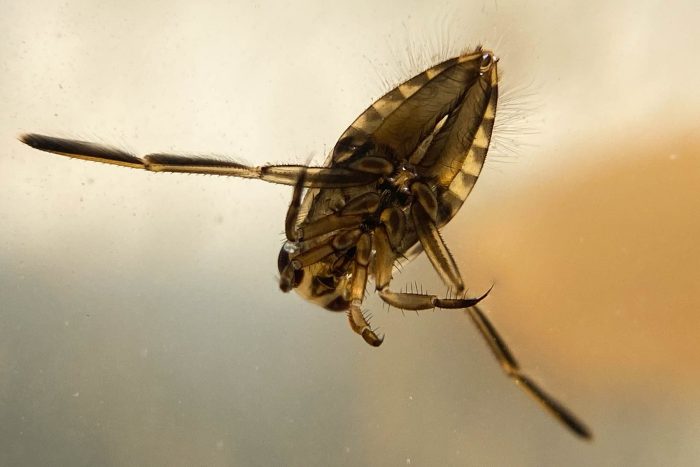Backswimmer
Notonectidae
The common backswimmer uses its powerful hind-legs to swim upside-down under the water's surface where it hunts its prey.
This section shows one large critter image at a time. Use the thumbnails that follow to select a specific image to display here.

This gallery contains a grid of small thumbnails. Selecting a thumbnail will change the main image in the preceding section.
Appearance
The common backswimmer is a light brown color with large, reddish eyes. Their most identifiable feature are their long hind legs that are used to propel themselves in the water. The area just behind their head is darker than the rest of its body, and their forewings can be a range of tan colors.
Feeding
Backswimmers prey on other aquatic insects and sometimes on small vertebrates and tadpoles.
Predators
Various other aquatic insects, fish and amphibians often prey on Backswimmers.
Reproduction and life cycle
Backswimmers adhere their elongated eggs to the stems of submerged plants. Generally, the young look like miniature versions of the adults, although they lack wings at this stage. The species lays their eggs in the fall or early spring and hatch after a few weeks.
Did you know?
Male backswimmers make scraping noises, similar to that of a cricket, that function to attract females for mating.
Backswimmers are also known as “greater water boatmen,” but the term backswimmer is used to avoid confusion with the similar “lesser water boatmen”
Although they are primarily aquatic, backswimmers can fly well and so can easily disperse to new habitats.
Backswimmers can inflict a painful bite on humans by stabbing them with their sharp mouthparts, but this is rare and often a result of mishandling.
Sources and additional information
Backswimmers - Missouri Department of Conservation
Common Backswimmer Notonecta Glauca - University of Florida IFAS Extension
Family Notonectidae- Backswimmers - Bug Guide
Common Backswimmer - The Wildlife Trusts
